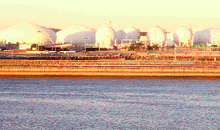OIL-GAS SEPARATION
 For kids
For kids
 Engineer version
Engineer version

At a specified temperature and pressure, the natural gas will separate from the oil. This concept is analogous to having a container of dry ice and a container of water and letting them sit at room temperature. At room temperature and atmospheric pressure, the lighter dry ice will vaporize. However, at room temperature, the heavier water in the container will not vaporize. In fact, the water will not boil off unless you heat it up to 100 oC. You can see how easily it is to separate dry ice from water. Just put the mix in a container and let it sit. The dry ice will vaporize out of the container while the water will remain basically intact.
Based on this concept, an adiabatic thermal flash column is used to separate the mixture. Because the natural gas has a lower boiling temperature than does the liquid oil, it will rise out of the top of the flash column as a vapor while the liquid oil will flow out of the bottom of the flash column. Operating at 65oF and at 500 psia pressure, the flash column will be able to separate the natural gas from the oil.
With natural gas recovered, the next step is to send it to another separation process to separate ethane from the other natural gas components.


 At a natural gas plant(Chevron), products such as ethane, propane and butane are separated into storage tanks.
At a natural gas plant(Chevron), products such as ethane, propane and butane are separated into storage tanks.